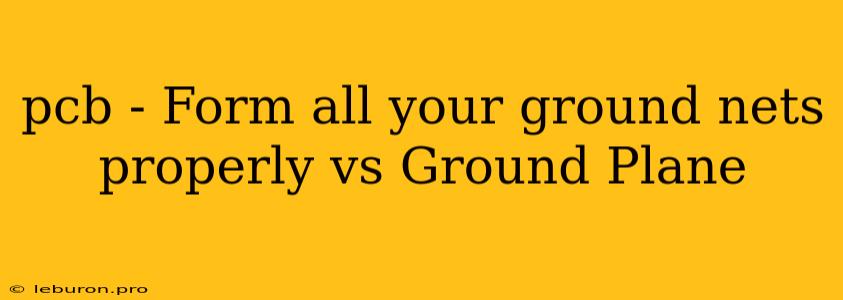Proper ground plane design is an essential aspect of Printed Circuit Board (PCB) design, ensuring signal integrity and minimizing noise. While many designers understand the importance of grounding, the choice between forming all ground nets properly versus utilizing a ground plane can be a source of confusion. Both methods have their advantages and disadvantages, and the optimal approach depends on the specific requirements of the circuit. This article will delve into the intricacies of both techniques, providing insights into their functionalities, benefits, and limitations to help you make informed decisions during your PCB design process.
Form All Ground Nets Properly
This approach involves treating each ground net as a separate entity, meticulously routing them throughout the PCB. This method offers a high degree of control over the grounding system, allowing for meticulous optimization of each individual ground connection. Here are some key aspects of forming all ground nets properly:
Advantages:
- Enhanced flexibility: This method allows for customized routing of each ground net, accommodating specific requirements for different circuit elements.
- Minimized inductance: By routing ground nets directly to their designated points, you minimize the loop area, reducing inductance and minimizing noise.
- Easier debugging: Individual ground nets are easier to trace and troubleshoot, simplifying the process of identifying and resolving grounding issues.
Disadvantages:
- Increased routing complexity: Routing individual ground nets can be time-consuming and complex, especially for large boards with numerous ground connections.
- Potential for ground loops: Improper routing of individual ground nets can lead to unintended ground loops, creating noise and signal integrity issues.
- Limited scalability: This approach becomes increasingly challenging to manage as the complexity of the circuit and number of ground nets increase.
Ground Plane
A ground plane is a continuous copper layer on one or more layers of the PCB, acting as a common reference point for all ground connections. The entire surface of the ground plane is connected to the ground reference point, providing a low-impedance path for ground currents to flow.
Advantages:
- Simplified routing: By utilizing a ground plane, you eliminate the need to individually route each ground net, significantly simplifying the design process.
- Reduced noise: The ground plane acts as a shield, minimizing noise from external sources and between different circuit components.
- Improved signal integrity: The low-impedance path provided by the ground plane enhances signal integrity by minimizing voltage drops and reducing noise.
Disadvantages:
- Increased board cost: Adding a ground plane layer increases the cost of the PCB fabrication process.
- Potential for coupling: Ground planes can introduce unwanted coupling between signals if not designed carefully.
- Limited flexibility: The ground plane provides a common reference point for all ground connections, limiting the flexibility for specialized ground routing.
Determining the Best Approach
Choosing between forming all ground nets properly and utilizing a ground plane depends on various factors, including the complexity of the circuit, the desired level of signal integrity, and the budget constraints. Here are some considerations:
- Circuit complexity: For simple circuits with a few ground connections, forming all ground nets properly may be sufficient. However, for complex circuits with numerous ground connections, a ground plane provides a more efficient and scalable solution.
- Signal integrity: If your circuit requires high signal integrity, utilizing a ground plane is often recommended. The low-impedance path provided by the ground plane helps minimize noise and voltage drops.
- Budget: Adding a ground plane layer increases the cost of the PCB fabrication process. However, it can significantly reduce the time and effort required for routing ground nets, potentially offsetting the cost increase in the long run.
Best Practices for Ground Plane Design
If you opt for a ground plane, proper design practices are crucial to ensure its effectiveness. Here are some key considerations:
- Placement: Strategically place the ground plane on the appropriate layers to minimize coupling and enhance shielding.
- Size: Ensure the ground plane is large enough to effectively accommodate all ground connections and currents.
- Connections: Connect all ground nets to the ground plane using vias or stitching capacitors to maintain a low impedance path.
- Avoid discontinuities: Minimize gaps and breaks in the ground plane to maintain its continuity and avoid potential noise sources.
Conclusion
Forming all ground nets properly and utilizing a ground plane are both valid approaches to grounding a PCB. The best method depends on the specific requirements of the circuit, the desired level of signal integrity, and the budget. Understanding the advantages and disadvantages of each approach allows you to make informed design decisions and achieve the desired performance for your PCB. While individual ground nets provide greater control and flexibility, a well-designed ground plane offers simplified routing, improved signal integrity, and enhanced noise reduction. By considering these factors, you can create a robust and reliable grounding system for your next PCB design.
